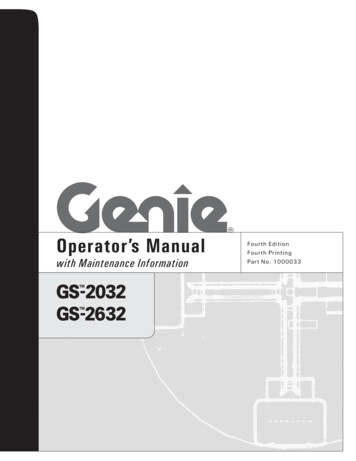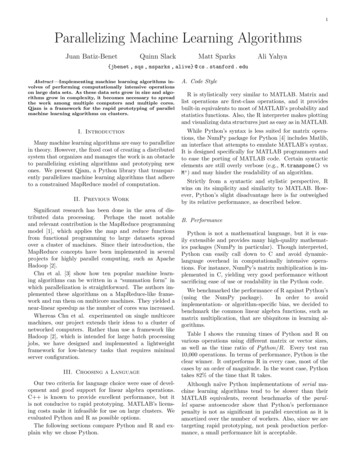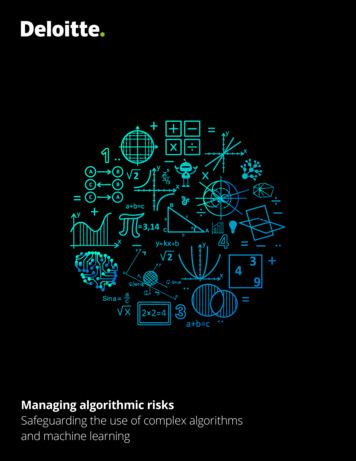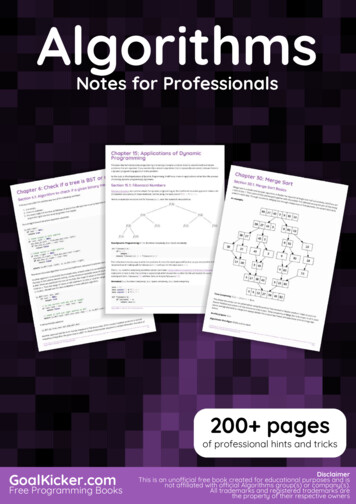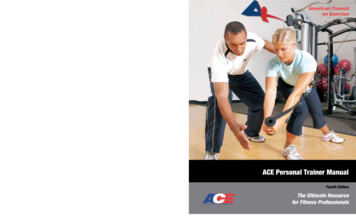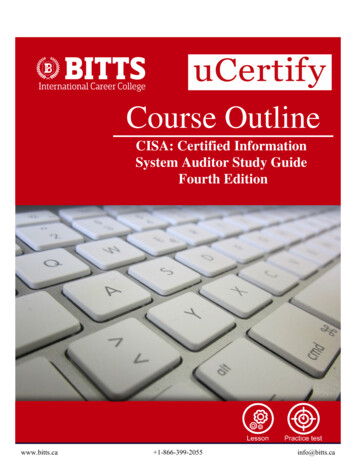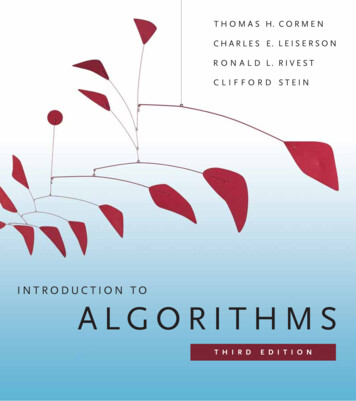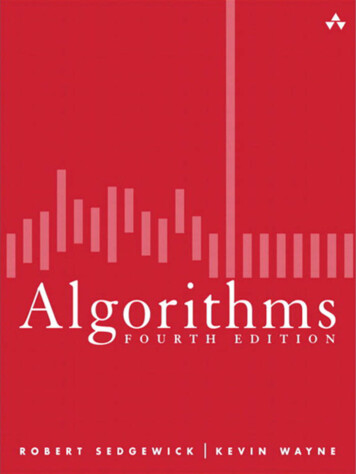
Transcription
AlgorithmsFOURTH EDITION
This page intentionally left blank
AlgorithmsFOURTH EDITIONRobert SedgewickandKevin WaynePrinceton UniversityUpper Saddle River, NJ Boston Indianapolis San FranciscoNew York Toronto Montreal London Munich Paris MadridCapetown Sydney Tokyo Singapore Mexico City
Many of the designations used by manufacturers and sellers to distinguish their products are claimed astrademarks. Where those designations appear in this book, and the publisher was aware of a trademarkclaim, the designations have been printed with initial capital letters or in all capitals.The authors and publisher have taken care in the preparation of this book, but make no expressed or implied warranty of any kind and assume no responsibility for errors or omissions. No liability is assumedfor incidental or consequential damages in connection with or arising out of the use of the information orprograms contained herein.The publisher offers excellent discounts on this book when ordered in quantity for bulk purchases orspecial sales, which may include electronic versions and/or custom covers and content particular to yourbusiness, training goals, marketing focus, and branding interests. For more information, please contact:U.S. Corporate and Government Sales(800) 382-3419corpsales@pearsontechgroup.comFor sales outside the United States, please contact:International Salesinternational@pearson.comVisit us on the Web:informit.com/awCataloging-in-Publication Data is on file with the Library of Congress.Copyright 2011 Pearson Education, Inc.All rights reserved. Printed in the United States of America. This publication is protected by copyright,and permission must be obtained from the publisher prior to any prohibited reproduction, storage ina retrieval system, or transmission in any form or by any means, electronic, mechanical, photocopying,recording, or likewise. For information regarding permissions, write to:Pearson Education, Inc.Rights and Contracts Department501 Boylston Street, Suite 900Boston, MA 02116Fax: (617) 671-3447ISBN-13: 978-0-321-57351-3ISBN-10:0-321-57351-XText printed in the United States on recycled paper at Courier in Westford, Massachusetts.First printing, March 2011
To Adam, Andrew, Brett, Robbieand especially LindaTo Jackie and Alex
CONTENTSPreface . . . . . . . . . . . . . . . . . . . . . . . . .viii1 Fundamentals . . . . . . . . . . . . . . . . . . . . . .31.1Basic Programming Model1.2Data Abstraction1.3Bags, Queues, and Stacks8641201.4 Analysis of Algorithms1721.5216Case Study: Union-Find2 Sorting . . . . . . . . . . . . . . . . . . . . . . . 2432.1Elementary Sorts2442.2Mergesort2702.3 Quicksort2882.4308Priority Queues2.5 Applications3363 Searching . . . . . . . . . . . . . . . . . . . . . . 361vi3.1Symbol Tables3623.2Binary Search Trees3963.3Balanced Search Trees4243.4Hash Tables4583.5 Applications486
4 Graphs . . . . . . . . . . . . . . . . . . . . . . . 5154.1Undirected Graphs5184.2Directed Graphs5664.3Minimum Spanning Trees6044.4Shortest Paths6385 Strings . . . . . . . . . . . . . . . . . . . . . . . 6955.1String Sorts7025.2Tries7305.3Substring Search7585.4Regular Expressions7885.5Data Compression8106 Context . . . . . . . . . . . . . . . . . . . . . . . 853Index . . . . . . . . . . . . . . . . . . . . . . . . . 933Algorithms . . . . . . . . . . . . . . . . . . . . . . 954Clients . . . . . . . . . . . . . . . . . . . . . . . . 955vii
PREFACEThis book is intended to survey the most important computer algorithms in use today,and to teach fundamental techniques to the growing number of people in need ofknowing them. It is intended for use as a textbook for a second course in computerscience, after students have acquired basic programming skills and familiarity with computersystems. The book also may be useful for self-study or as a reference for people engaged inthe development of computer systems or applications programs, since it contains implementations of useful algorithms and detailed information on performance characteristics andclients. The broad perspective taken makes the book an appropriate introduction to the field.the study of algorithms and data structures is fundamental to any computerscience curriculum, but it is not just for programmers and computer-science students. Everyone who uses a computer wants it to run faster or to solve larger problems. The algorithmsin this book represent a body of knowledge developed over the last 50 years that has becomeindispensable. From N-body simulation problems in physics to genetic-sequencing problemsin molecular biology, the basic methods described here have become essential in scientificresearch; from architectural modeling systems to aircraft simulation, they have become essential tools in engineering; and from database systems to internet search engines, they havebecome essential parts of modern software systems. And these are but a few examples—as thescope of computer applications continues to grow, so grows the impact of the basic methodscovered here.Before developing our fundamental approach to studying algorithms, we develop datatypes for stacks, queues, and other low-level abstractions that we use throughout the book.Then we survey fundamental algorithms for sorting, searching, graphs, and strings. The lastchapter is an overview placing the rest of the material in the book in a larger context.viii
Distinctive features The orientation of the book is to study algorithms likely to be ofpractical use. The book teaches a broad variety of algorithms and data structures and provides sufficient information about them that readers can confidently implement, debug, andput them to work in any computational environment. The approach involves:Algorithms. Our descriptions of algorithms are based on complete implementations and ona discussion of the operations of these programs on a consistent set of examples. Instead ofpresenting pseudo-code, we work with real code, so that the programs can quickly be put topractical use. Our programs are written in Java, but in a style such that most of our code canbe reused to develop implementations in other modern programming languages.Data types. We use a modern programming style based on data abstraction, so that algorithms and their data structures are encapsulated together.Applications. Each chapter has a detailed description of applications where the algorithmsdescribed play a critical role. These range from applications in physics and molecular biology,to engineering computers and systems, to familiar tasks such as data compression and searching on the web.A scientific approach. We emphasize developing mathematical models for describing theperformance of algorithms, using the models to develop hypotheses about performance, andthen testing the hypotheses by running the algorithms in realistic contexts.Breadth of coverage. We cover basic abstract data types, sorting algorithms, searching algorithms, graph processing, and string processing. We keep the material in algorithmic context, describing data structures, algorithm design paradigms, reduction, and problem-solvingmodels. We cover classic methods that have been taught since the 1960s and new methodsthat have been invented in recent years.Our primary goal is to introduce the most important algorithms in use today to as wide anaudience as possible. These algorithms are generally ingenious creations that, remarkably, caneach be expressed in just a dozen or two lines of code. As a group, they represent problemsolving power of amazing scope. They have enabled the construction of computational artifacts, the solution of scientific problems, and the development of commercial applicationsthat would not have been feasible without them.ix
Booksite An important feature of the book is its relationship to the booksitealgs4.cs.princeton.edu. Thissite is freely available and contains an extensive amount ofmaterial about algorithms and data structures, for teachers, students, and practitioners, including:An online synopsis. The text is summarized in the booksite to give it the same overall structure as the book, but linked so as to provide easy navigation through the material.Full implementations. All code in the book is available on the booksite, in a form suitable forprogram development. Many other implementations are also available, including advancedimplementations and improvements described in the book, answers to selected exercises, andclient code for various applications. The emphasis is on testing algorithms in the context ofmeaningful applications.Exercises and answers. The booksite expands on the exercises in the book by adding drillexercises (with answers available with a click), a wide variety of examples illustrating thereach of the material, programming exercises with code solutions, and challenging problems.Dynamic visualizations. Dynamic simulations are impossible in a printed book, but thewebsite is replete with implementations that use a graphics class to present compelling visualdemonstrations of algorithm applications.Course materials. A complete set of lecture slides is tied directly to the material in the bookand on the booksite. A full selection of programming assignments, with check lists, test data,and preparatory material, is also included.Links to related material. Hundreds of links lead students to background information aboutapplications and to resources for studying algorithms.Our goal in creating this material was to provide a complementary approach to the ideas.Generally, you should read the book when learning specific algorithms for the first time orwhen trying to get a global picture, and you should use the booksite as a reference when programming or as a starting point when searching for more detail while online.x
Use in the curriculum The book is intended as a textbook in a second course in computer science. It provides full coverage of core material and is an excellent vehicle for students to gain experience and maturity in programming, quantitative reasoning, and problemsolving. Typically, one course in computer science will suffice as a prerequisite—the book isintended for anyone conversant with a modern programming language and with the basicfeatures of modern computer systems.The algorithms and data structures are expressed in Java, but in a style accessible topeople fluent in other modern languages. We embrace modern Java abstractions (includinggenerics) but resist dependence upon esoteric features of the language.Most of the mathematical material supporting the analytic results is self-contained (oris labeled as beyond the scope of this book), so little specific preparation in mathematics isrequired for the bulk of the book, although mathematical maturity is definitely helpful. Applications are drawn from introductory material in the sciences, again self-contained.The material covered is a fundamental background for any student intending to majorin computer science, electrical engineering, or operations research, and is valuable for anystudent with interests in science, mathematics, or engineering.Context The book is intended to follow our introductory text, An Introduction to Programming in Java: An Interdisciplinary Approach, which is a broad introduction to the field.Together, these two books can support a two- or three-semester introduction to computer science that will give any student the requisite background to successfully address computationin any chosen field of study in science, engineering, or the social sciences.The starting point for much of the material in the book was the Sedgewick series of Algorithms books. In spirit, this book is closest to the first and second editions of that book, butthis text benefits from decades of experience teaching and learning that material. Sedgewick’scurrent Algorithms in C/C /Java, Third Edition is more appropriate as a reference or a textfor an advanced course; this book is specifically designed to be a textbook for a one-semestercourse for first- or second-year college students and as a modern introduction to the basicsand a reference for use by working programmers.xi
Acknowledgments This book has been nearly 40 years in the making, so full recognition of all the people who have made it possible is simply not feasible. Earlier editions of thisbook list dozens of names, including (in alphabetical order) Andrew Appel, Trina Avery, MarcBrown, Lyn Dupré, Philippe Flajolet, Tom Freeman, Dave Hanson, Janet Incerpi, Mike Schidlowsky, Steve Summit, and Chris Van Wyk. All of these people deserve acknowledgement,even though some of their contributions may have happened decades ago. For this fourthedition, we are grateful to the hundreds of students at Princeton and several other institutionswho have suffered through preliminary versions of the work, and to readers around the worldfor sending in comments and corrections through the booksite.We are grateful for the support of Princeton University in its unwavering commitmentto excellence in teaching and learning, which has provided the basis for the development ofthis work.Peter Gordon has provided wise counsel throughout the evolution of this work almostfrom the beginning, including a gentle introduction of the “back to the basics” idea that isthe foundation of this edition. For this fourth edition, we are grateful to Barbara Wood forher careful and professional copyediting, to Julie Nahil for managing the production, andto many others at Pearson for their roles in producing and marketing the book. All were extremely responsive to the demands of a rather tight schedule without the slightest sacrifice tothe quality of the result.Robert SedgewickKevin WaynePrinceton, NJJanuary, 2011xii
This page intentionally left blank
ONEFundamentals1.1Basic Programming Model. . . . . . . . . 81.2Data Abstraction . . . . . . . . . . . . . . 641.3Bags, Queues, and Stacks . . . . . . . 1201.4Analysis of Algorithms . . . . . . . . . 1721.5Case Study: Union-Find. . . . . . . . . 216
The objective of this book is to study a broad variety of important and usefulalgorithms—methods for solving problems that are suited for computer implementation. Algorithms go hand in hand with data structures—schemes for organizing data that leave them amenable to efficient processing by an algorithm. Thischapter introduces the basic tools that we need to study algorithms and data structures.First, we introduce our basic programming model. All of our programs are implemented using a small subset of the Java programming language plus a few of our ownlibraries for input/output and for statistical calculations. Section 1.1 is a summary oflanguage constructs, features, and libraries that we use in this book.Next, we emphasize data abstraction, where we define abstract data types (ADTs) inthe service of modular programming. In Section 1.2 we introduce the process of implementing an ADT in Java, by specifying an applications programming interface (API)and then using the Java class mechanism to develop an implementation for use in clientcode.As important and useful examples, we next consider three fundamental ADTs: thebag, the queue, and the stack. Section 1.3 describes APIs and implementations of bags,queues, and stacks using arrays, resizing arrays, and linked lists that serve as models andstarting points for algorithm implementations throughout the book.Performance is a central consideration in the study of algorithms. Section 1.4 describes our approach to analyzing algorithm performance. The basis of our approach isthe scientific method: we develop hypotheses about performance, create mathematicalmodels, and run experiments to test them, repeating the process as necessary.We conclude with a case study where we consider solutions to a connectivity problemthat uses algorithms and data structures that implement the classic union-find ADT.3
4CHAPTER 1 FundamentalsAlgorithms When we write a computer program, we are generally implementing amethod that has been devised previously to solve some problem. This method is oftenindependent of the particular programming language being used—it is likely to beequally appropriate for many computers and many programming languages. It is themethod, rather than the computer program itself, that specifies the steps that we cantake to solve the problem. The term algorithm is used in computer science to describea finite, deterministic, and effective problem-solving method suitable for implementation as a computer program. Algorithms are the stuff of computer science: they arecentral objects of study in the field.We can define an algorithm by describing a procedure for solving a problem in anatural language, or by writing a computer program that implements the procedure,as shown at right for Euclid’s algorithm for finding the greatest common divisor oftwo numbers, a variant of which was devisedover 2,300 years ago. If you are not familiar English-language descriptionwith Euclid’s algorithm, you are encourCompute the greatest common divisor oftwo nonnegative integers p and q as follows:aged to work Exercise 1.1.24 and ExerciseIf q is 0, the answer is p. If not, divide p by q1.1.25, perhaps after reading Section 1.1. Inand take the remainder r. The answer is thethis book, we use computer programs to degreatest common divisor of q and r.scribe algorithms. One important reason fordoing so is that it makes easier the task of Java-language descriptionpublic static int gcd(int p, int q)checking whether they are finite, determin{istic, and effective, as required. But it is alsoif (q 0) return p;int r p % q;important to recognize that a program in areturn gcd(q, r);particular language is just one way to express}an algorithm. The fact that many of the alEuclid’s algorithmgorithms in this book have been expressedin multiple programming languages over thepast several decades reinforces the idea that each algorithm is a method suitable forimplementation on any computer in any programming language.Most algorithms of interest involve organizing the data involved in the computation. Such organization leads to data structures, which also are central objects of studyin computer science. Algorithms and data structures go hand in hand. In this book wetake the view that data structures exist as the byproducts or end products of algorithmsand that we must therefore study them in order to understand the algorithms. Simplealgorithms can give rise to complicated data structures and, conversely, complicatedalgorithms can use simple data structures. We shall study the properties of many datastructures in this book; indeed, we might well have titled the book Algorithms and DataStructures.
CHAPTER 1 FundamentalsWhen we use a computer to help us solve a problem, we typically are faced with anumber of possible approaches. For small problems, it hardly matters which approachwe use, as long as we have one that correctly solves the problem. For huge problems (orapplications where we need to solve huge numbers of small problems), however, wequickly become motivated to devise methods that use time and space efficiently.The primary reason to learn about algorithms is that this discipline gives us thepotential to reap huge savings, even to the point of enabling us to do tasks that wouldotherwise be impossible. In an application where we are processing millions of objects,it is not unusual to be able to make a program millions of times faster by using a welldesigned algorithm. We shall see such examples on numerous occasions throughoutthe book. By contrast, investing additional money or time to buy and install a newcomputer holds the potential for speeding up a program by perhaps a factor of only 10or 100. Careful algorithm design is an extremely effective part of the process of solvinga huge problem, whatever the applications area.When developing a huge or complex computer program, a great deal of effort mustgo into understanding and defining the problem to be solved, managing its complexity, and decomposing it into smaller subtasks that can be implemented easily. Often,many of the algorithms required after the decomposition are trivial to implement. Inmost cases, however, there are a few algorithms whose choice is critical because mostof the system resources will be spent running those algorithms. These are the types ofalgorithms on which we concentrate in this book. We study fundamental algorithmsthat are useful for solving challenging problems in a broad variety of applications areas.The sharing of programs in computer systems is becoming more widespread, soalthough we might expect to be using a large fraction of the algorithms in this book, wealso might expect to have to implement only a small fraction of them. For example, theJava libraries contain implementations of a host of fundamental algorithms. However,implementing simple versions of basic algorithms helps us to understand them better and thus to more effectively use and tune advanced versions from a library. Moreimportant, the opportunity to reimplement basic algorithms arises frequently. The primary reason to do so is that we are faced, all too often, with completely new computingenvironments (hardware and software) with new features that old implementationsmay not use to best advantage. In this book, we concentrate on the simplest reasonableimplementations of the best algorithms. We do pay careful attention to coding the critical parts of the algorithms, and take pains to note where low-level optimization effortcould be most beneficial.The choice of the best algorithm for a particular task can be a complicated process,perhaps involving sophisticated mathematical analysis. The branch of computer science that comprises the study of such questions is called analysis of algorithms. Many5
6CHAPTER 1 Fundamentalsof the algorithms that we study have been shown through analysis to have excellenttheoretical performance; others are simply known to work well through experience.Our primary goal is to learn reasonable algorithms for important tasks, yet we shall alsopay careful attention to comparative performance of the methods. We should not usean algorithm without having an idea of what resources it might consume, so we striveto be aware of how our algorithms might be expected to perform.Summary of topics As an overview, we describe the major parts of the book, giving specific topics covered and an indication of our general orientation toward thematerial. This set of topics is intended to touch on as many fundamental algorithms aspossible. Some of the areas covered are core computer-science areas that we study indepth to learn basic algorithms of wide applicability. Other algorithms that we discussare from advanced fields of study within computer science and related fields. The algorithms that we consider are the products of decades of research and development andcontinue to play an essential role in the ever-expanding applications of computation.Fundamentals (Chapter 1) in the context of this book are the basic principles andmethodology that we use to implement, analyze, and compare algorithms. We considerour Java programming model, data abstraction, basic data structures, abstract datatypes for collections, methods of analyzing algorithm performance, and a case study.Sorting algorithms (Chapter 2) for rearranging arrays in order are of fundamentalimportance. We consider a variety of algorithms in considerable depth, including insertion sort, selection sort, shellsort, quicksort, mergesort, and heapsort. We also encounter algorithms for several related problems, including priority queues, selection,and merging. Many of these algorithms will find application as the basis for other algorithms later in the book.Searching algorithms (Chapter 3) for finding specific items among large collectionsof items are also of fundamental importance. We discuss basic and advanced methodsfor searching, including binary search trees, balanced search trees, and hashing. Wenote relationships among these methods and compare performance.Graphs (Chapter 4) are sets of objects and connections, possibly with weights andorientation. Graphs are useful models for a vast number of difficult and importantproblems, and the design of algorithms for processing graphs is a major field of study.We consider depth-first search, breadth-first search, connectivity problems, and several algorithms and applications, including Kruskal’s and Prim’s algorithms for findingminimum spanning tree and Dijkstra’s and the Bellman-Ford algorithms for solvingshortest-paths problems.
CHAPTER 1 FundamentalsStrings (Chapter 5) are an essential data type in modern computing applications.We consider a range of methods for processing sequences of characters. We begin withfaster algorithms for sorting and searching when keys are strings. Then we considersubstring search, regular expression pattern matching, and data-compression algorithms. Again, an introduction to advanced topics is given through treatment of someelementary problems that are important in their own right.Context (Chapter 6) helps us relate the material in the book to several other advancedfields of study, including scientific computing, operations research, and the theory ofcomputing. We survey event-based simulation, B-trees, suffix arrays, maximum flow,and other advanced topics from an introductory viewpoint to develop appreciation forthe interesting advanced fields of study where algorithms play a critical role. Finally, wedescribe search problems, reduction, and NP-completeness to introduce the theoreticalunderpinnings of the study of algorithms and relationships to material in this book.The study of algorithms is interesting and exciting because it is a new field(almost all the algorithms that we study are less than 50 years old, and some were justrecently discovered) with a rich tradition (a few algorithms have been known for hundreds of years). New discoveries are constantly being made, but few algorithms arecompletely understood. In this book we shall consider intricate, complicated, and difficult algorithms as well as elegant, simple, and easy ones. Our challenge is to understandthe former and to appreciate the latter in the context of scientific and commercial applications. In doing so, we shall explore a variety of useful tools and develop a style ofalgorithmic thinking that will serve us well in computational challenges to come.7
1.1BASIC PROGRAMMING MODELOur study of algorithms is based upon implementing them as programs written inthe Java programming language. We do so for several reasons: Our programs are concise, elegant, and complete descriptions of algorithms. You can run the programs to study properties of the algorithms. You can put the algorithms immediately to good use in applications.These are important and significant advantages over the alternatives of working withEnglish-language descriptions of algorithms.A potential downside to this approach is that we have to work with a specific programming language, possibly making it difficult to separate the idea of the algorithmfrom the details of its implementation. Our implementations are designed to mitigatethis difficulty, by using programming constructs that are both found in many modernlanguages and needed to adequately describe the algorithms.We use only a small subset of Java. While we stop short of formally defining thesubset that we use, you will see that we make use of relatively few Java constructs, andthat we emphasize those that are found in many modern programming languages. Thecode that we present is complete, and our expectation is that you will download it andexecute it, on our test data or test data of your own choosing.We refer to the programming constructs, software libraries, and operating systemfeatures that we use to implement and describe algorithms as our programming model.In this section and Section 1.2, we fully describe this programming model. The treatment is self-contained and primarily intended for documentation and for your reference in understanding any code in the book. The model we describe is the same modelintroduced in our book An Introduction to Programming in Java: An InterdisciplinaryApproach, which provides a slower-paced introduction to the material.For reference, the figure on the facing page depicts a complete Java program thatillustrates many of the basic features of our programming model. We use this code forexamples when discussing language features, but defer considering it in detail to page46 (it implements a classic algorithm known as binary search and tests it for an application known as whitelist filtering). We assume that you have experience programmingin some modern language, so that you are likely to recognize many of these features inthis code. Page references are included in the annotations to help you find answers toany questions that you might have. Since our code is somewhat stylized and we striveto make consistent use of various Java idioms and constructs, it is worthwhile even forexperienced Java programmers to read the information in this section.8
1.1Basic Programming Modelimport a Java library (see page 27)import java.util.Arrays;code must be in file BinarySearch.java (see page 26)parameterpublic class BinarySearchvariablesstatic method (see page 22){public static int rank(int key, int[] a){initializingreturn typeparameter typedeclaration statementint lo 0;(see page 16)int hi a.length - 1;while (lo hi)expression (see page 11){int mid lo (hi - lo) / 2;if(key a[mid]) hi mid - 1;loop statementelse if (key a[mid]) lo mid 1;(see page 15)elsereturn mid;}return -1;return statement}system calls main()unit test client (see page 26)public static void main(String[] args){no return value; just side effects (see page 24)int[] whitelist In.readInts(args[0]);Arrays.s
The algorithms and data structures are expressed in Java, but in a style accessible to people fluent in other modern languages. We embrace modern Java abstractions (including generics) but resist dependence upon esoteric features of the language. Most of the mathematical mater
